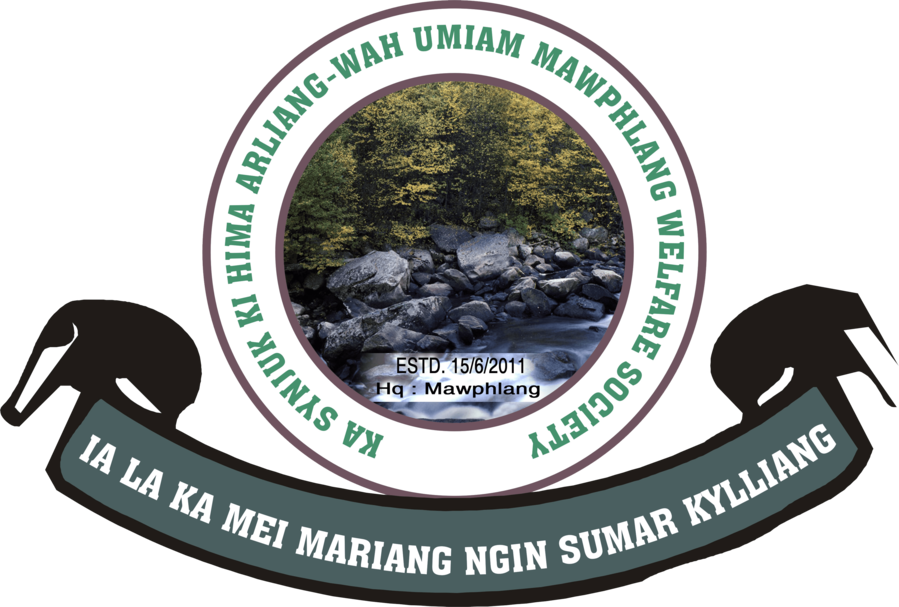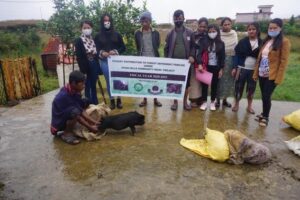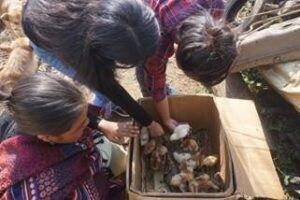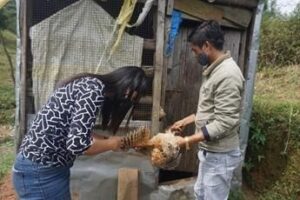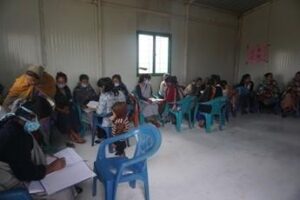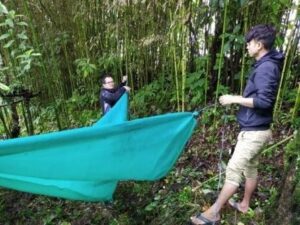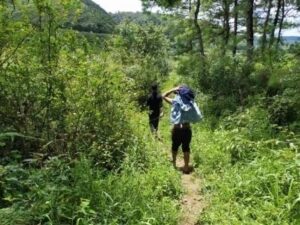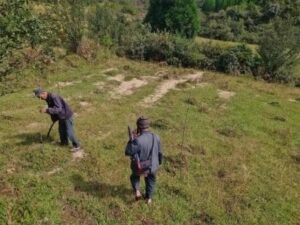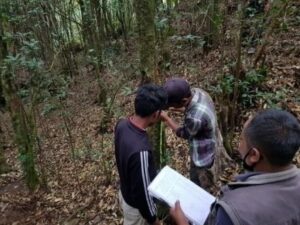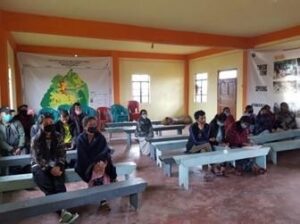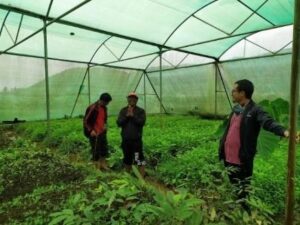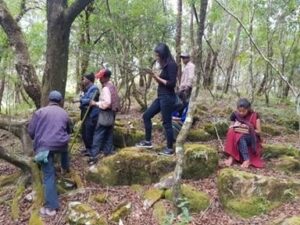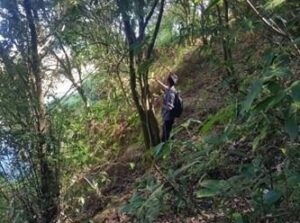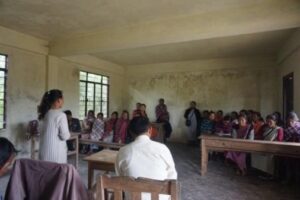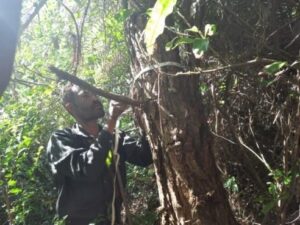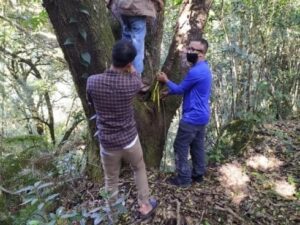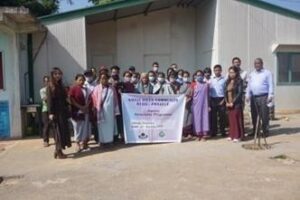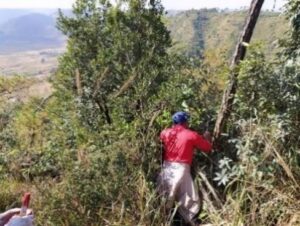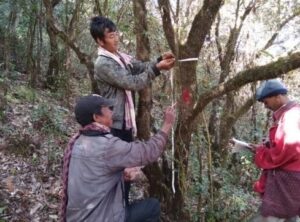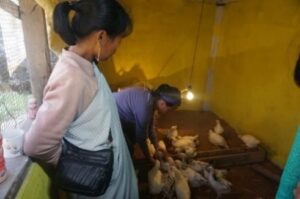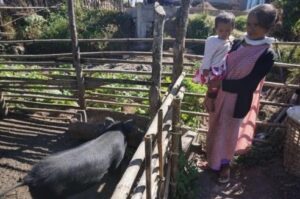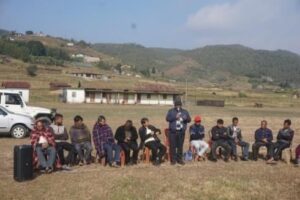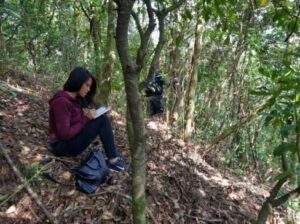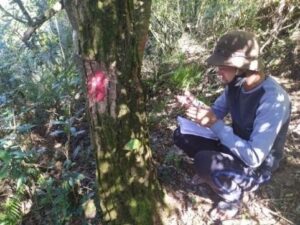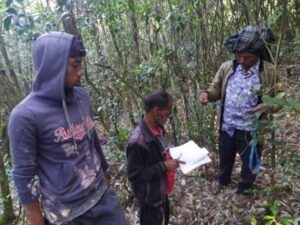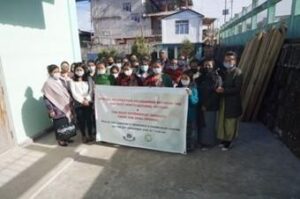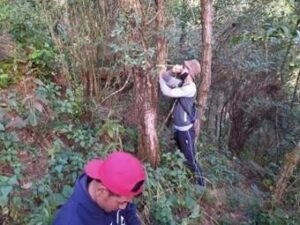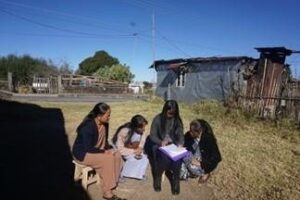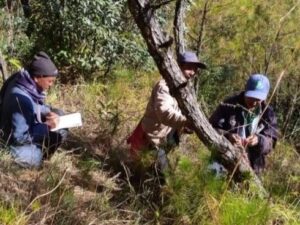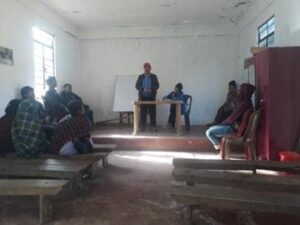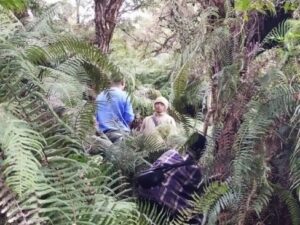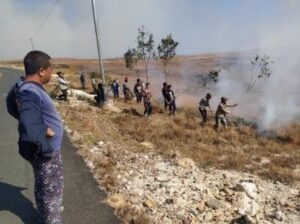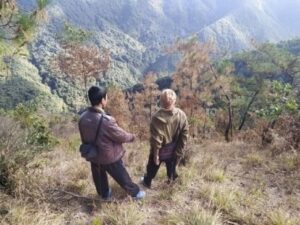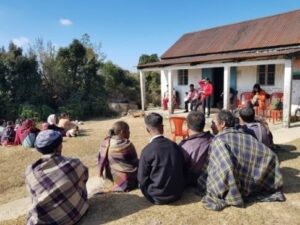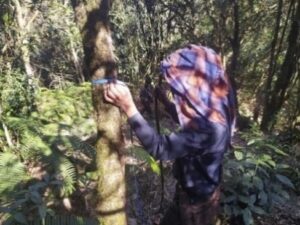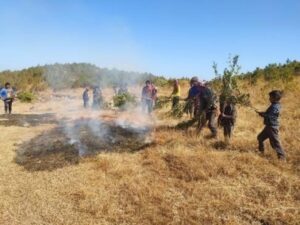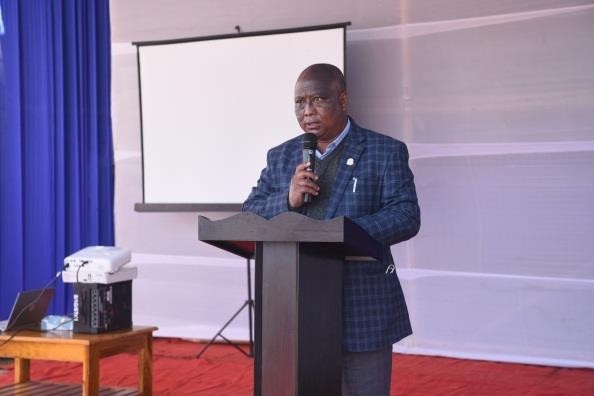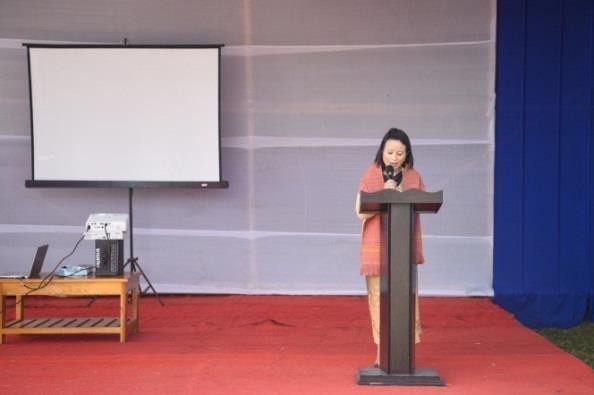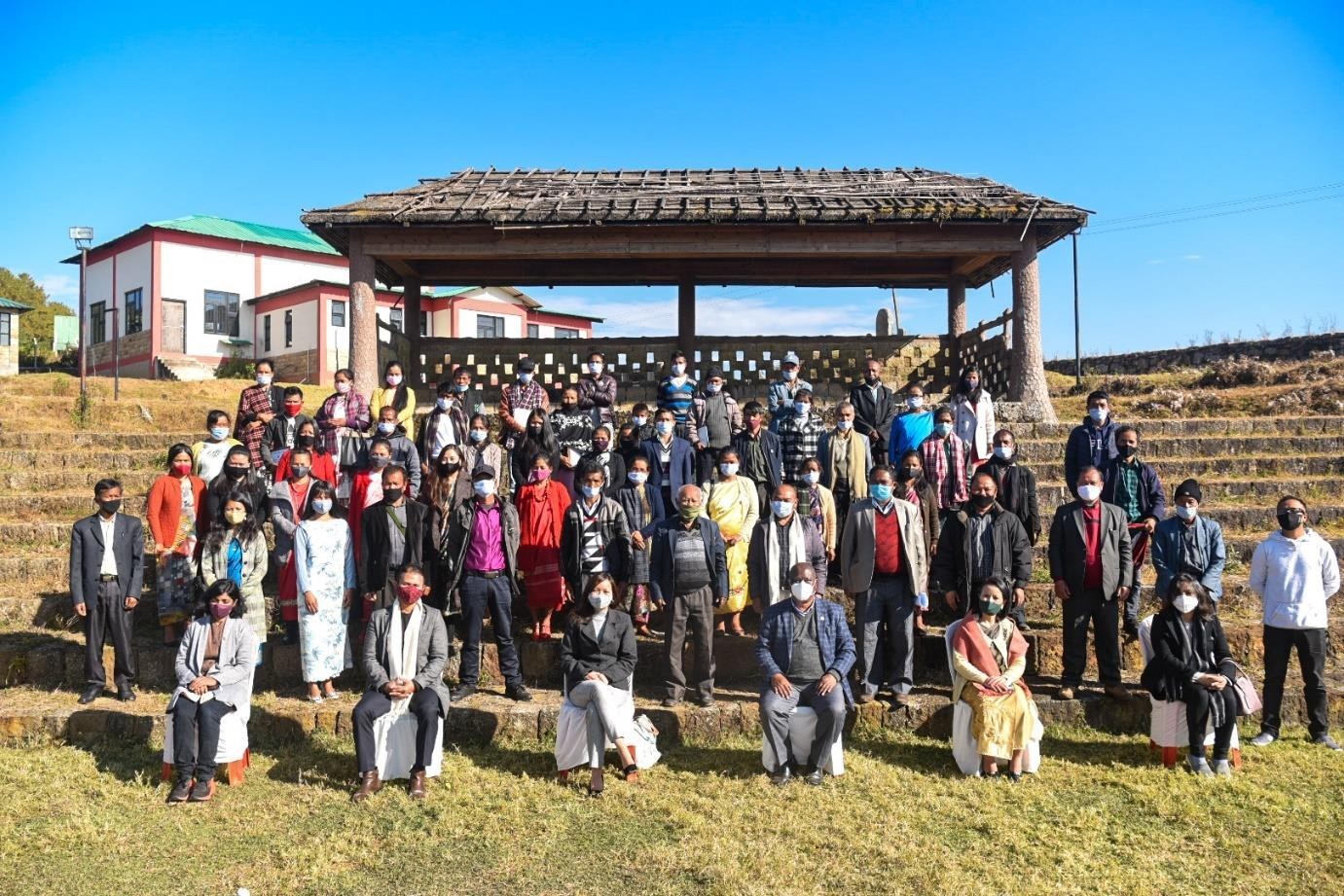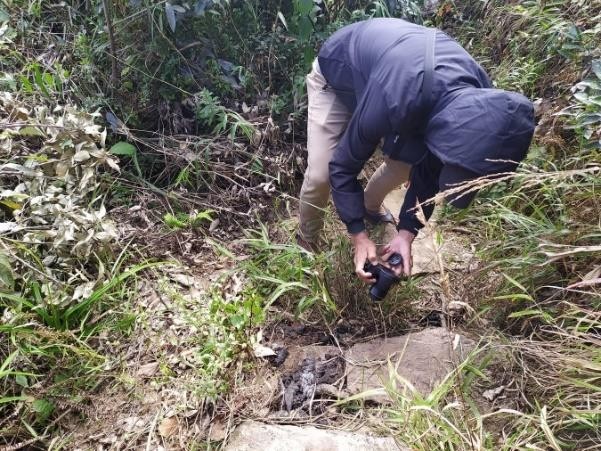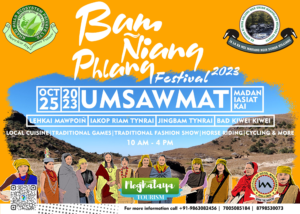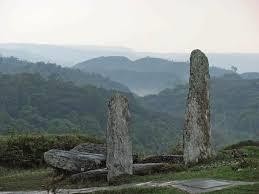
KHASI HILLS COMMUNITY PROJECT
4th QUARTER REPORT OCT-DEC 2020
The Khasi Hills Community Project is implemented by the Ka Synjuk Ki Hima Arliang Wah Umiam Welfare Society, a Federation of 10 indigenous Khasi governments (Hima) representing 70 participating communities guided by their village councils (Durbar).
PROJECT SUMMARY
The Khasi Hills Community Project is nearing 10 years of successful operation. The project has mobilized approximately 7,000 families to protect and restore 9,250 hectares of old-growth, montane cloud forests in the Umiam River Watershed. In addition, project communities are working to regenerate over 5,000 hectares of degraded forest. In return for their efforts to save their community forests from logging, forest fires, mining, and conversion to agriculture, the project provides communities with a diverse set of social and economic activities. The goal is to increase household income in the 70 participating villages, where 90 percent of the families are below India’s poverty line, while also improving public health through the provision of clean drinking water systems and smokeless cooking technologies to reduce household air pollution.
Response to COVID-19 Global Pandemic
The COVID-19 pandemic has decreased in Meghalaya and movement throughout the state is becoming less restricted. The participants in the 70 villages of the project area continue to follow guidelines set in place by the state and practice hygiene procedures to reduce the spread. At the time of writing, the number of active cases in the state of Meghalaya is 192. Community facilitators and youth volunteers have continued with forest patrols, monitoring, and tree planting. The Meet and Fest which was organized for the SHGs in December was planned in a matter to allow for social distancing in an outdoor venue.
Forest Habitat and Wildlife Conservation
Conserving the montane cloud forests along the steep banks of the Umiam River is a major goal of the project. The dense forests drop over 500 meters to the rushing waters of the River which subsequently flows into Bangladesh. The historic David Scott Trail constructed in the early 19th century, winds its way up the river gorge and has become a popular hiking route and tourist destination. A portion of the trail is on project land and the community constructed rest stops and provides maps and guides. It continues to be an important eco- tourism community project. Forest conservation is complemented by community efforts to restore forest fragments on the hill tops above the river, creating a wildlife corridor that extends from the 2,000-meter plateau down to the Bangladesh plains. This habitat supports a broad range of birdlife, reptiles, and mammals, as well as amphibians and fish, some of which are found only in this area. An important project strategy to reduce deforestation and forest degradation is community-based forest fire control. The project has continued to train local Community Facilitators in monitoring the production, transport, and use of charcoal within the project area. The monsoon season came to an end in the beginning of the 4th quarter, however there were two fires reported in the project area in November and December which were caused by uncontrolled charcoal burning on private land that spread into the project area. During December, participants of 13 communities in the project area were active in making fire line in order to reduce wildfire prior to the dry months ahead. Continuing education programmes are being implemented to educate local charcoal makers on fire safety as well.
Degraded Forest Restoration
With over 5,700 hectares of degraded forest land, the project seeks to restore these areas to improve wildlife habitat, increase the hydrological function of the watershed, and sequester atmospheric carbon. Each participating village identifies the degraded community forests that they want to restore and agrees to close the land to firewood collection, grazing, and agriculture. The villages receive support from the project to clear fire lines, remove weeds and scrub, and open space for emerging saplings. Gaps are filled with seedlings and saplings. Nearly 2,000 hectares of land have been restored in this way over the past eight years. Villages are finding that restoring the watershed is resulting in better stream flow levels, as well as water availability in the dry season.
Clean Energy Transition
Household firewood consumption for cooking and heating is a major driver of deforestation in the project area as well as contributing to indoor smoke pollution that causes respiratory illness. In addition, fuelwood burning also is a major source of carbon emissions. To address these problems, the project is working to supply all project families with LPG cooktops, LPG tanks, and electric rice cookers. Adoption of gas cooktops has reduced firewood consumption an average of 2.75 kgs of fuelwood per day for each household. Fuelwood continues to be monitored by youth volunteers in the communities.
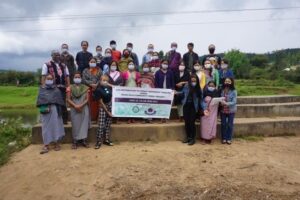 To get a better understanding of how families use fuel currently, including fuelwood and charcoal, the project is conducting ongoing surveys based on fuel needs and current arrangements. This will also provide information on which families are already implementing LPG and which would like to do so in the future. During the 4th quarter the project allocated 637 new LPG connections to beneficiaries.
To get a better understanding of how families use fuel currently, including fuelwood and charcoal, the project is conducting ongoing surveys based on fuel needs and current arrangements. This will also provide information on which families are already implementing LPG and which would like to do so in the future. During the 4th quarter the project allocated 637 new LPG connections to beneficiaries.
Sustainable Agriculture
With most families dependent on farming for their income, improving agricultural practices has been a project priority. The project team seeks to assist families from a heavy dependence on low value potato cultivation to diversify into horticulture, green house vegetable growing, and organic farming. After the project distributed green houses, village families have been able to start cultivating cauliflower, broccoli, mint, coriander, eggplant, mustard leaf, chillies, and turnips to generate income. SHGs are also involved with vermicomposting to increase value-added products to their marketable goods and for use in their own agricultural practices. During this quarter, chicks and piglets were distributed to several beneficiaries and SHGs in the project area to expand their production.
Eco-Tourism and Cultural Conservation
At the time of writing ecotourism sites are beginning to reopen in the area. This is a much- needed benefit to many in the Mawphlang area who had depended on tourism for part of their livelihood. Guides are eager to share the cultural beauty with others and have been provided with the necessary protective gear and trained in how to proceed in a sector that is still susceptible to Covid implications.
Community Horticulture
As part of the project’s sustainable agriculture program which includes organic farming techniques, vermiculture, and composting the project team is also providing high value fruit trees to project families. This helps diversify farm produce, especially low value potato farming on which many families depend. Fruit trees also provide produce that can be converted to value added jams and jellies. The fruit trees are found to have a high survival rate when protected from grazing animals.
Additionally, project sponsored polyhouses have provided shelter from the heavy rains to produce ornamental flowers and bedding plants which have a good market in Meghalaya.
Mushroom Cultivation
The project continues to oversee a mushroom cultivation programme and has been expanding this high value production system given the conducive moist, high elevation environment. Oyster mushrooms bring in a good return for local families once the mushroom house has been constructed. Spores which were difficult to procure during the Covid lockdown have once again become available and have been distributed to several beneficiaries.
Community Development Grants
Each year the project provides the 70 participating communities with community development grants to fund projects that benefit many village families. The villages prepare proposals for priority projects. The current projects which were monitored in the 3rd quarter had used the funds for repairing schools, building water tanks, and increasing sanitation in their villages.
Project Updates
- October 2020
- November 2020
- December 2020
5 October 2020
The Socio-Economic Team (SET) conducted the SHG assessment of the SHG members along with the LCF at Umsawmat village. Nine SHGs attended from Hima Lyngiong. On the same day the SET along with a staff member from the Block, Miss Davinia Kurkalang, gave the vaccination to 280 layer chickens.
6 October 2020
The SET conducted the SHG assessment of the SHG members along with the LCF at Thainthynroh village. Ten SHGs attended. The SET along with the Forestry Team met with the Coffee Board in Nongthymmai, Shillong to seek information on coffee plantation.
6 & 7 October 2020
The Forestry Team went for data collection in Umdiengpoh and Tyrsad village.
7 & 28 October 2020
The Forestry Team along with the Asst CF and Youth Volunteers of Hima Mawphlang set up a seed trap to collect seeds of Michelia sp. at Nongrum and Lyngkien Sunei, Hima Mawphlang.
7, 16, 22 & 29 October 2020
The SET distributed 33 piglets to beneficiaries in Hima Sohra, Hima Nongkhlaw, Hima Lyngiong, Hima Pamsanngut, Hima Mawbeh, Hima Mawphlang, and Hima Nonglwai.
9 October 2020
The SET along with the Forestry Team conducted an orientation on the Project for 16 Youth Volunteers and 5 CFs from Hima Mawphlang and Hima Nonglwai. On the same day, training on VKR was conducted by Miss Beautiful Lyngdoh, the SET Field Reporting Supervisor.
12 October 2020
The Forestry Team went to Lyngkien Sunei, Hima Mawphlang for mapping of ANR site (Rimaiong) with an area of about 10 Hectares. The CF of Hima Mawphlang, Local YV and Headman of Sunei village were also present.
16 October 2020
The Forestry Team monitored ANR at Law Adong Laitkynsew. It was reported by the CF of Hima Laitkroh that almost 90 tree saplings planted in the area were affected by flooding due to heavy rainfall.
22 October 2020
The Forestry Team monitored the plot at Kyrphei village.
24 October 2020
The LWC of Kyrphei Cluster held a meeting at the Community Hall.
27 October 2020
The Forestry Team along with the CF and Asst. CF of Hima Mawphlang monitored the Home-Based Nursery and distributed nursery bags for plantation at Kyiem.
29 October 2020
The Forestry Team monitored the plot in Mawmyrsiang village.
30 October 2020
The Forestry Team monitored the plot in Sohrarim.
03 November 2020
The Socio-Economic Team met with the 21 participants of the newly adopted SHG in Laitsohphlang village, Hima Mylliem on the activities carried out by the project. Miss Beautiful Lyngdoh, Field Reporting Supervisor explained the activities carried out by the project and the main objective of the
project. The two SHGs are Iatyllilang SHG and Nginiengbantei SHG.
03, 04, 06 & 12 November 2020
Training of plot monitoring took place at Lumdidum Hima Mawphlang, Hima Lyngiong, Pamsanngut, and Mawbeh. The activity was presented to refresh the methodologies and protocols that are needed for plot monitoring.
05 November 2020
The Project Director along with the Socio-Economic Team and Forestry Team organised an awareness programme on the activities carried out by the project at Mawkyrdep village, Ri Bhoi District.
10 November 2020
The Socio-Economic Team distributed layer chicks to 22 individual beneficiaries.
17 November 2020
Plot monitoring took place at Kyndong Kyiem Carbon Plot with Youth Volunteers and the Assistant CF of Hima Mawphlang.
18 November 2020
Plot monitoring took place at Laitumiong and Hima Sohra.
18 & 19 November 2020
The beneficiaries were visited in Hima Nongspung, Pamsanngut, Mylliem, Laitkroh, and Nongkhlaw for monitoring and follow-up of poultry and piggery.
19 November 2020
The Project Director along with the SET and Forestry Team conducted and awareness programme at Wahrahaw village. There were 26 participants during the awareness programme.
19 November 2020
Plot monitoring took place at Hima Sohra.
24 November 2020
ANR plots were monitored at Phanniewlah, Lyngiong and Mawphlang.
25 November 2020
Plots were monitored at Phanniewlahneng and 2.5 km of firelines were made at Lumniewkor.
26 November 2020
The Socio-Economic Team along with the SHG members had a special interaction with the District Horticulture Officer (DHO) on Farmer Producer Organisation (FPO). There were 19 participants who attended the interaction.
27 November 2020
Plots were monitored at Kyndong Lum Kmie Brial, Mawmyrsiang.
01 December 2020
The Socio-Economic Team conducted the best performance assessment of Self Help Groups through a questionnaire format.
01 December 2020
The Forestry Team monitored the carbon plot at Lumdiengsai along with the CF and Youth Volunteers of Hima Laitkroh.
01 & 03 December 2020
The LWCs of Dympep and Laitlyndop Clusters held meetings in their respective locations.
04 December 2020
The Forestry Team monitored the carbon plot at Lumwaharkum, Hima Nonglwai along with the CF and Youth Volunteers.
16 December 2020
The Forestry Team monitored the fire lines at Mawkma which the local community of Mawkma village actively participated in. The total length of fireline is 12 km.
22 December 2020
The Forestry Team measured the area affected by forest fire at Nonglwai LumNonglyer along with the CF and Youth Volunteer of Hima Nonglwai. On 1st December, a fire that threatened 2.5 ha hectares was successfully put out by community effort due to fire training by the Synjuk. It was determined that the fire was the result of unusually dry conditions and caused by charcoal making on private land that the Synjuk does not control. Measures are being implemented to educate local charcoal makers on fire safety measures.
23 December 2020
An Awareness Programme was held at Mawbri village, Hima Sohra. The village of 20 households participated in the programme. The Forestry Team and Socio-Economic Team each gave a brief description of the work of the Project.
28 December 2020
The Forestry Team monitored the carbon plot at Laitumiong, Hima Mawbeh along with the CF and local Youth Volunteers of Hima Mawbeh.
29 December 2020
The Forestry Team monitored the making of firelines at Mawpalong in which the local village of Mawrohroh actively particpated to cover a length of 3.5 km.
SHG Interviews
The SET conducted interviews with the SHGs who performed well. While interviewing the SHGs, members shared their success stories and appreciated the Synjuk for giving meaningful suggestions and direction to the women members of the SHGs for their livelihood activities and for being proactive in helping and providing funds to the SHG and farmers. The three top performing SHGs were given special awards at the SHG Meet and Fest held in December 2020. Below are the interviews and photos of each group.
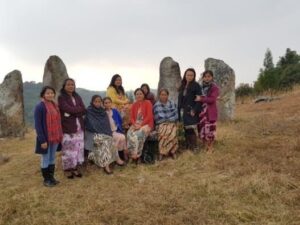 Interview with Ridalin Lyndem from Umdiengpoh, Hima Sohra. The group was formed on the 9th November 2011 and joined with the Synjuk in 2014. The name of the group is ‘Nangiaikyntiew SHG’. The activities of the group are many, but the group will share only few activities such as livestock rearing, farming, and internal loaning within the members of the group to support each other in the group. The group says that the Synjuk has guided and supported the group in so many ways such as taking good care of the forest by not cutting down the trees and by decreasing the use of firewood. Community Facilitators usually visit 12 or 13 times in a year and the Socio-Economic team visited two or three times a year. Other benefits for the members of the group provided by the Synjuk are LPG connection, distribution of rice cooker, and many more. The group deeply appreciates the Synjuk and its team for support and guidance while allowing the group to stand on their own feet by not depending on others. The group hopes that Synjuk will support and uplift the group and the villages in the days to come.
Interview with Ridalin Lyndem from Umdiengpoh, Hima Sohra. The group was formed on the 9th November 2011 and joined with the Synjuk in 2014. The name of the group is ‘Nangiaikyntiew SHG’. The activities of the group are many, but the group will share only few activities such as livestock rearing, farming, and internal loaning within the members of the group to support each other in the group. The group says that the Synjuk has guided and supported the group in so many ways such as taking good care of the forest by not cutting down the trees and by decreasing the use of firewood. Community Facilitators usually visit 12 or 13 times in a year and the Socio-Economic team visited two or three times a year. Other benefits for the members of the group provided by the Synjuk are LPG connection, distribution of rice cooker, and many more. The group deeply appreciates the Synjuk and its team for support and guidance while allowing the group to stand on their own feet by not depending on others. The group hopes that Synjuk will support and uplift the group and the villages in the days to come.
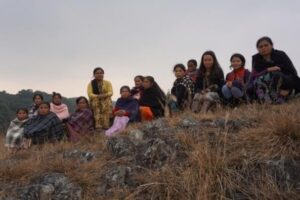 The group was formed on the 3rd November 2011 and joined with the Synjuk in the year 2012. The Synjuk has aided the group in many ways, but importantly giving support on how to preserve and conserve the forest, natural resources and habitat biodiversity. The activities that the group is working on are organic farming, livestock rearing, and internal loaning. Internal loaning helps the group in lifting up the economic status. The Socio-Economic Team usually visits three times a year and the Community Facilitator visits 12 times a year. Assistance and guidance of the Synjuk has benefitted the group and broadened the mindset of the group. Some of the benefits that the group members have received are LPG connection, temperate fruit trees, and poultry. The group express its gratitude and appreciation to the Synjuk for giving meaningful suggestions and direction to the women members of the SHG for their livelihood activities and for being proactive in helping and providing funds to the SHG and farmers.
The group was formed on the 3rd November 2011 and joined with the Synjuk in the year 2012. The Synjuk has aided the group in many ways, but importantly giving support on how to preserve and conserve the forest, natural resources and habitat biodiversity. The activities that the group is working on are organic farming, livestock rearing, and internal loaning. Internal loaning helps the group in lifting up the economic status. The Socio-Economic Team usually visits three times a year and the Community Facilitator visits 12 times a year. Assistance and guidance of the Synjuk has benefitted the group and broadened the mindset of the group. Some of the benefits that the group members have received are LPG connection, temperate fruit trees, and poultry. The group express its gratitude and appreciation to the Synjuk for giving meaningful suggestions and direction to the women members of the SHG for their livelihood activities and for being proactive in helping and providing funds to the SHG and farmers.
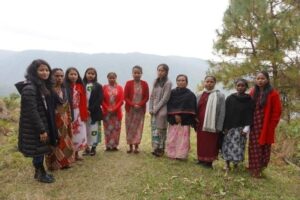 Interview with Iarilin Nongrum. The group formed on 15th April 2018 and the group joined with the Synjuk on 3rd July 2018. The name of the group is Umpohliew SHG. The activities that the group carries out are livestock rearing, farming, and internal loaning. By giving loans, it helps the group members in their economic status. Support from the Synjuk has given a huge benefit to the group and the villagers. The group has received trainings and awareness programmes as well as LPG gas, solar lights, rice cookers, poultry, and temperate fruit trees. The Synjuk not only helped with training for bookkeeping for the SHG, but also supported the group to take care of the environment by preserving and conserving the forest for future generations. The Synjuk has helped to encourage, strengthen, and broaden the mindset of the group. The Socio-Economic Team visited the group three times a year and the Community Facilitator visited once a month throughout the year. The group expressed their gratitude, appreciation, and gratefulness to the Synjuk and Socio-Economic Team for paving new avenues for the SHG.
Interview with Iarilin Nongrum. The group formed on 15th April 2018 and the group joined with the Synjuk on 3rd July 2018. The name of the group is Umpohliew SHG. The activities that the group carries out are livestock rearing, farming, and internal loaning. By giving loans, it helps the group members in their economic status. Support from the Synjuk has given a huge benefit to the group and the villagers. The group has received trainings and awareness programmes as well as LPG gas, solar lights, rice cookers, poultry, and temperate fruit trees. The Synjuk not only helped with training for bookkeeping for the SHG, but also supported the group to take care of the environment by preserving and conserving the forest for future generations. The Synjuk has helped to encourage, strengthen, and broaden the mindset of the group. The Socio-Economic Team visited the group three times a year and the Community Facilitator visited once a month throughout the year. The group expressed their gratitude, appreciation, and gratefulness to the Synjuk and Socio-Economic Team for paving new avenues for the SHG.
Report of the SHG Meet and Fest 2020
The Socio-Economic Team organized the 5th Annual Self Help Group Meet and Fest on 12 December 2020. There were 88 participants in attendance at the programme, including dignitaries District Commissioner of East Khasi Hills District Smt. I. Laloo, District Forest Officer, Wildlife Division East Khasi Hills District, Smt. A. P. James, Block Development Officer Mawphlang Community and Rural Development Block, Smt. E. Warjri, the Lyngdoh Hima Mawphlang Lyngdohship, Shri C. A. Lyngdoh. The Self Help Groups and Farmer’s Clubs, the Community Facilitators and the Youth Volunteers were among those present as well.
Ms. Ibadapbiang Lyngdoh Kynshi, Socio-Economic Specialist of Khasi Hills REDD+ Community Project, chaired the programme. A welcome speech was given by the Project Director of Khasi Hills REDD+ Community Project, Mr. Tambor Lyngdoh, whereby he welcomed all the participants in the programme. Mr. Tambor Lyngdoh briefed about the activities implemented by the project. Mr. Tambor Lyngdoh encouraged the people to preserve and conserve the forests located in their villages in order to preserve the natural resources and biodiversity.
A speech was given by the President of the Synjuk, Myntri L. Blah, who encouraged and showed his support for the Synjuk in its mission to preserve the environment, stating that the nature or environment we live in today was borrowed from the previous generations. Therefore, we must take good care of it so as to enable the future generation to enjoy the same.
The Lyngdoh of Hima Mawphlang Lyngdohship, Shri. C. A. Lyngdoh, then expressed that the Hima is delighted to witness the work of the Synjuk in preserving the forests and extended its support towards the Synjuk.
A speech was also given by the BDO of Mawphlang C&RD Block, Smt. E. Warjri, who expressed an immense gratitude towards the Synjuk for the work that has been done in preserving and conserving the forest. Smt. E. Warjri mentioned that SHGs are very important in uplifting the economic growth of the community people. Smt. E. Warjri stated that an individual may face financial support, particularly when an individual or a family has less income sources, by joining with the SHG. Smt. E. Warjri encouraged the members of the SHGs to remain under the umbrella of the SHGs and to spread the message that women in particular should register themselves with the SHGs for their economic growth and the welfare of the society.
Awards and certificates were given to the best performing LWCs, SHGs and Farmer’s Clubs. The best performing LWCs were Laitkynsew Cluster, Mawlumtyrsad Cluster, and Wahlynkien Ramklang Cluster. Special awards were distributed to 66 members of the community who have contributed in environmental services by controlling forest fire in Hima Laitkroh, Hima Pamsanngut, Hima Mawphlang, and Hima Nongspung. Those who participated in animal rescue throughout the year were also recognized and applauded for their efforts.
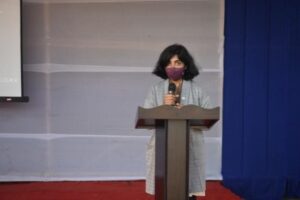 A speech and video presentation on wildlife biodiversity was given by Smt. A. P. James, the District Forest Officer, Wild Life Division East Khasi Hills District. Smt. A. P. James was immensly impressed that the SHGs are performing well and happy to see the young men and women having so much confidence. She said, “They are really stepping up their life, and not only their life but also rendering services towards preserving and conserving of the forest.” Smt. E. Warjri congratulated all the winners and SHG members on the wonderful work for their livelihood, care for their environment, and for imbibing the values of the community.
A speech and video presentation on wildlife biodiversity was given by Smt. A. P. James, the District Forest Officer, Wild Life Division East Khasi Hills District. Smt. A. P. James was immensly impressed that the SHGs are performing well and happy to see the young men and women having so much confidence. She said, “They are really stepping up their life, and not only their life but also rendering services towards preserving and conserving of the forest.” Smt. E. Warjri congratulated all the winners and SHG members on the wonderful work for their livelihood, care for their environment, and for imbibing the values of the community.
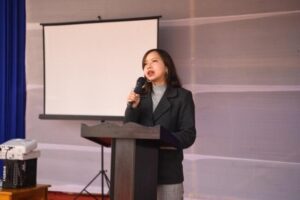 The Deputy Commissioner of East Khasi Hills District, Smt. I. Laloo expressed that she was immensely pleased to witness the Sacred Grove being fullfilled with all the rituals of our ancestors, forefathers, and leaders alike. She deeply appreciated the vision of the ancestors which serves as the best example not only to the Hima, the district, the state, but to the whole world. Smt. I. Laloo also mentioned that there are three parts to the success story of the day. First being unity. Rarely one can see any Hima which joins hands together to make people aware of the project; to come together under one umbrella of the Synjuk so as to empower and educate the people more. Local knowldege is an utmost importance at present as this knowledge will help the future generation not to lose sight of the vision of our ancestors. Through hardwork and farsightness of the SHGs, the future generations will be more blessed.
The Deputy Commissioner of East Khasi Hills District, Smt. I. Laloo expressed that she was immensely pleased to witness the Sacred Grove being fullfilled with all the rituals of our ancestors, forefathers, and leaders alike. She deeply appreciated the vision of the ancestors which serves as the best example not only to the Hima, the district, the state, but to the whole world. Smt. I. Laloo also mentioned that there are three parts to the success story of the day. First being unity. Rarely one can see any Hima which joins hands together to make people aware of the project; to come together under one umbrella of the Synjuk so as to empower and educate the people more. Local knowldege is an utmost importance at present as this knowledge will help the future generation not to lose sight of the vision of our ancestors. Through hardwork and farsightness of the SHGs, the future generations will be more blessed.
The programme ended with a vote of thanks from Project Director of Khasi Hills REDD+ Community Project, Mr. Tambor Lyngdoh and a group photo was taken.
